小学英语说课稿(深圳朗文版)
- 格式:docx
- 大小:16.17 KB
- 文档页数:3
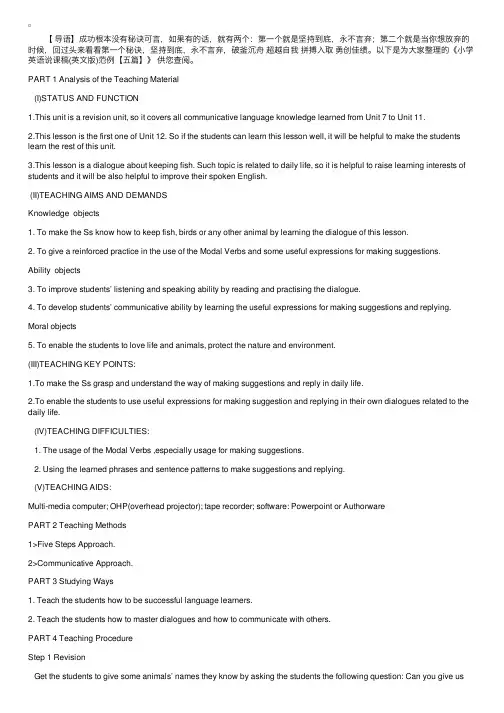
【导语】成功根本没有秘诀可⾔,如果有的话,就有两个:第⼀个就是坚持到底,永不⾔弃;第⼆个就是当你想放弃的时候,回过头来看看第⼀个秘诀,坚持到底,永不⾔弃,破釜沉⾈超越⾃我拼搏⼊取勇创佳绩。
以下是为⼤家整理的《⼩学英语说课稿(英⽂版)范例【五篇】》供您查阅。
PART 1 Analysis of the Teaching Material(I)STATUS AND FUNCTION1.This unit is a revision unit, so it covers all communicative language knowledge learned from Unit 7 to Unit 11.2.This lesson is the first one of Unit 12. So if the students can learn this lesson well, it will be helpful to make the students learn the rest of this unit.3.This lesson is a dialogue about keeping fish. Such topic is related to daily life, so it is helpful to raise learning interests of students and it will be also helpful to improve their spoken English.(II)TEACHING AIMS AND DEMANDSKnowledge objects1. To make the Ss know how to keep fish, birds or any other animal by learning the dialogue of this lesson.2. To give a reinforced practice in the use of the Modal Verbs and some useful expressions for making suggestions.Ability objects3. To improve students’ listening and speaking ability by reading and practising the dialogue.4. To develop students’ communicative ability by learning the useful expressions for making suggestions and replying. Moral objects5. To enable the students to love life and animals, protect the nature and environment.(III)TEACHING KEY POINTS:1.To make the Ss grasp and understand the way of making suggestions and reply in daily life.2.To enable the students to use useful expressions for making suggestion and replying in their own dialogues related to the daily life.(IV)TEACHING DIFFICULTIES:1. The usage of the Modal Verbs ,especially usage for making suggestions.2. Using the learned phrases and sentence patterns to make suggestions and replying.(V)TEACHING AIDS:Multi-media computer; OHP(overhead projector); tape recorder; software: Powerpoint or AuthorwarePART 2 Teaching Methods1>Five Steps Approach.2>Communicative Approach.PART 3 Studying Ways1. Teach the students how to be successful language learners.2. Teach the students how to master dialogues and how to communicate with others.PART 4 Teaching ProcedureStep 1 RevisionGet the students to give some animals’ names they know by asking the students the following question: Can you give ussome names of different animals you know? This step is employed to revise the words related the animals. At the same time draw the students’ attention to the topic about animals.Step 2 Lead-inSign to the students to be quiet and close their books. Then start a free talk with the students. Use computer to show some pictures of different pets, such as dogs, cats etc. Ask the students several questions about raising pets. These questions are employed to warm up the students and raise the interests of the students to speak English in class on the topics they like and familiar with.Good morning, everyone!Today, I’ll say something about Unit 9 Part A in Book 4 of Oxford English.Background on the reformation of curriculum, this book can connect the life and act, emphasize the interest and experience of the Ss, the pictures are active and vivid. Grade four is the initial stage of English learning, so it stresses on the emotion of the Ss, creates a well beginning for the Ss. This Unit has 7 parts, we’ll learn Part A mainly, it embodies the repeating characterize. Review the learned language points “Where’s…”and the new language points will be represented in the following units. So this unit forms connecting links with a special meaning in this book.The content of this period is to use “Where’s\are…” to determine the place. And according to the contents and the fact of the Ss, I establish the following three teaching aims of this period:The first one: students can listen, read, say and spell the following words: a glass, a fridge, an egg, bread and a table.The second one: students can listen, read, say and write the following daily expressions: What’s for breakfast?Have some juice then.The third one: students can listen, read, say and write the following sentence patterns: Where’s\Where are the\my…It’s \They’re…There’s no …in \on \near…I think the most difficult point of this period is to make sure the students can use the patterns “Where’s\Where are…and There is no …in\on\near…” in their daily life correctly.And I will use some pictures, words and sentence cards, a tape recorder and the multi-media computer to help me achieve the aims.The task-based method, communicated method, group cooperate method will be used in this period.To accomplish the aims, I design the following steps:Step 1 Songs and the game arousers the emotion.In order to attract the Ss’ attention and construct an atmosphere of learning English, I let the students sing some English songs and play the game “Simon says”. At the same time the game can review the prep, serve the knowledge as foil and consist the appearance of the knowledge.Step 2 Change class to life, happy to say.The substance of language is communication and the environment of communication is life. So when I present the sentence pattern “What’s for breakfast?” I first show a clock to elicit the time for breakfast, teach the sentence. Then show my own photo of having breakfast, Ss ask and guess. In this way I can attract Ss’ attention, encourage Ss to ask Qs with the new knowledge.Most of the Ss have learnt the sentence pattern: Where’s…? so I design a task for Ss to help Helen find the food and drinks for breakfast, and teach the new language points: Where are…?They’re … Meanwhile stick the sentences on the Bb.After some practice by asking and answering, I present the next language points:There’s no …in\on\near…Have …then.And I will stick these sentence patterns on the Bb. Finally I’ll let the Ss do pair works to consolidate them.Step 3 Listen to the tape and Ss imitate to read and say.As the new reformation of curriculum, emphasized the traditional class attach importance to the mechanical teaching, neglect the experience and participation, for example, the five-step method. So in this lesson, after presentation, I ask Ss to listen to the tape with three Qs, read in different roles and in pairs, then try to recite the text.Step 4 Ss be the main body, T makes a guider.In class, Ss play as a host, and the T makes an influence on guiding, help Ss to act the learnt dialogue, it can stress the position of the Ss, and arouse their interest.Then I show a carton with no voice, ask Ss to make a dialogue in pairs.There are lots of ways to consolidate the new knowledge. Playing game is a good way. So according to the physiology of Ss, I hold a group competition during the game, ask Ss to finish the blanks. In this way can develop Ss’ good habits and achieve the aim of mastering the learned knowledge in situation.Step 5 Change class to life, learn by themselves.Is this the end of the class? I don’t think so. If there is an end, I think it should be in the life. So I extend this class, encourage Ss to use the learned to communicate with each other in their life.In a word, the whole period is based on tasks, which are designed from easy steps to steps that are challenging. When the Ss are carting out the tasks, they can acquire information, knowledge, and have their ability and skills trained.Thank you!。
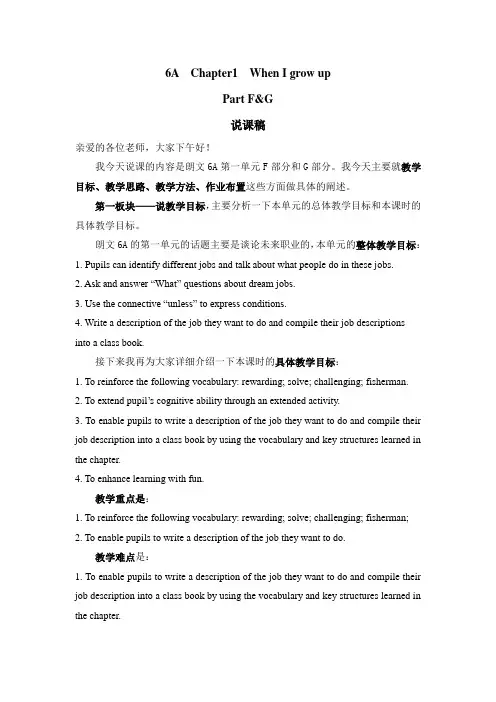
6A Chapter1 When I grow upPart F&G说课稿亲爱的各位老师,大家下午好!我今天说课的内容是朗文6A第一单元F部分和G部分。
我今天主要就教学目标、教学思路、教学方法、作业布置这些方面做具体的阐述。
第一板块——说教学目标,主要分析一下本单元的总体教学目标和本课时的具体教学目标。
朗文6A的第一单元的话题主要是谈论未来职业的,本单元的整体教学目标:1. Pupils can identify different jobs and talk about what people do in these jobs.2. A sk and answer “What” questions about dream jobs.3. U se the connective “unless” to express conditions.4. Write a description of the job they want to do and compile their job descriptions into a class book.接下来我再为大家详细介绍一下本课时的具体教学目标:1. To reinforce the following vocabulary: rewarding; solve; challenging; fisherman.2. To extend pupil’s cognitive ability through an extended activity.3. To enable pupils to write a description of the job they want to do and compile their job description into a class book by using the vocabulary and key structures learned in the chapter.4. To enhance learning with fun.教学重点是:1. To reinforce the following vocabulary: rewarding; solve; challenging; fisherman;2. To enable pupils to write a description of the job they want to do.教学难点是:1. To enable pupils to write a description of the job they want to do and compile their job description into a class book by using the vocabulary and key structures learned in the chapter.第二板块——说教学思路我把教学过程分为以下几个环节:1. Introduce the context.2. Demonstrate how to complete John’s job description.3. Practice.4. Learn the song with fun.5. Show time第一环节情景介绍分5块,用时10分钟:1.1 Display Part F.【设定情景,展示相关信息,通过图片和文字引发学生共鸣】1.2 Go through the two personal descriptions of jobs with pupils by pointing out the notes in the green boxes.【引导学生根据材料中出现的提示语,学会自己寻找关键信息,锻炼学生获取文本信息的能力】1.3 Encourage the pupils to make a table and write the information they find in the description.【鼓励学生将获取的信息进行比较和整合,用表格的形式直观地展示】1.4 Pupils share their tables and information with each other.【同学间信息共享,了解其他同学信息整合的方法】1.5 Pupils read the two descriptions together.第二环节分为3块,用时5分钟:2.1 Instruct pupils to read the information about John Smith silently and complete his job description individually.【引导学生运用已经掌握的方法,完成相关练习】2.2 Go around the class and check pupils’ understanding.2.3 Check pupil’s answers to Part F.第三环节分为2块,用时8分钟:3.1 In pairs, pupils talk with their partner about what they want to be when they grow up.【引发话题,激发学生交流和讨论的欲望】3.2 Pupils write down their job description and share them with others.【仿照课文中的素材,完成自己的工作描述】第四环节分为4块,用时10分钟:4.1 Display the song in Part F.4.2 Point at the title and ask for some information.4.3 Divide the pupils into three groups. Instruct Group1 to sing the first verse, Group2 sing the second verse and Group3 sing the third verse.4.4 Encourage pupils to think about another verse about their dream jobs and sing about their dream job.【鼓励学生发挥创意,将自己完成的工作描述改编成歌曲,富有趣味性地进行语言地拓展和运用。
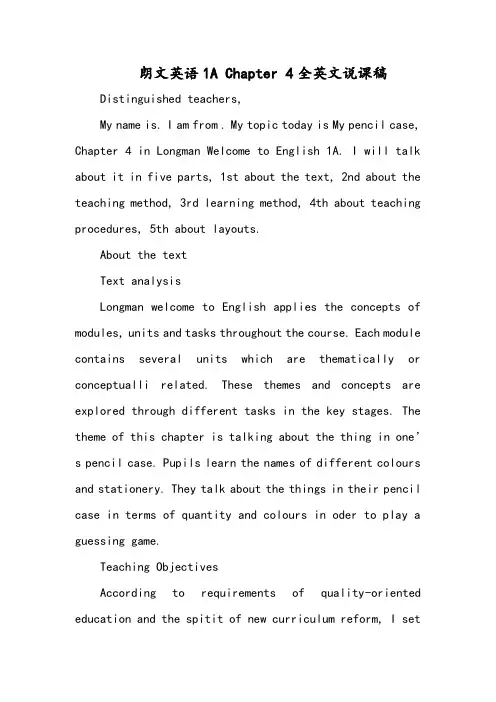
朗文英语1A Chapter 4全英文说课稿Distinguished teachers,My name is. I am from . My topic today is My pencil case, Chapter 4 in Longman Welcome to English 1A. I will talk about it in five parts, 1st about the text, 2nd about the teaching method, 3rd learning method, 4th about teaching procedures, 5th about layouts.About the textText analysisLongman welcome to English applies the concepts of modules, units and tasks throughout the course. Each module contains several units which are thematically or conceptualli related. These themes and concepts are explored through different tasks in the key stages. The theme of this chapter is talking about the thing in one’s pencil case. Pupils learn the names of different colours and stationery. They talk about the things in their pencil case in terms of quantity and colours in oder to play a guessing game.Teaching ObjectivesAccording to requirements of quality-oriented education and the spitit of new curriculum reform, I setmy teaching objective as follows:To introduce pupils to the names of different colours and stationery.To encourage pupils to talk about the quantity and colours of different stationery. By the end of this lesson, the pupils will be able to describe his/her pencil case, using colours and quantity.Learning TargetsTo provide or find out and present simple information on familiar topicsTo recongnise some obvious features of the English Language in simple spoken and written texts such as the direction of writing in English, the characteristics of an alphabetic script and the sound as the direction of writing in English, the characteristics of and alphabetic script and the sound patterns of English; and apply this awareness to one’s initial and use of the language.Teaching procedure:First I will greet my pupils as usual, ask them how are you and listen and comment on their response. Few timeslater, I will ask them to look around the classroom in Christmas atmosphere. Try to collect the colours in the classroom. Meanwhile, I will put the specific colours on the white board. After they give all the colours out, I will show them a rainbow without colour. This can arouse their interest in talking about colours because they will give colours to the pale rainbow. Through this, they can practice what they’ve learnt. Give comments to this part.E.g. as long as you all master the colour, I will give you a magic box! To go to the next part about stationery fluently.I will introduce the magic box in a very mysterious voice to draw the pupils attention.e.g. I bring a magic box for you! Do you want to know what’s inside? Please put your hand in it and touch! Pick one!Then I will ask one of them come to the front and ask What is this?Take it out, please!Pupil will guess what it is according to what they feel.And I will give comments like Great! You are so smart! Meanwhile I will ask the weaker ones to repeat.At the end of this part, I will bring all the flash cardsabout stationery to the white board. Ask them to read one by one.Then I will transite to the next part: What a lovely magic box! I also have four magic pencil case today! Let’s open it! See what’s inside? II will first say Oh, I have … and wait for the pupils to finish the sentence. I will set levels here, Level 1: I have a pencil. What colour is it? It is red.Level 2: I have a blue pen.Level 3: I have 3 red pencils/erasers.After this, Pupils understand how can they describe their pencil canse, so I will give pencile case to them and let them prepare and talk about it. Do you want to discover what’s inside these four pencil cases? One for each group. Open it!They will discuss in groups. And after most of them finish, I will first invite good kids to demonstrate. Later on, most of them will be able to express their ideas.By the end of the lesson, I will conclude and give Homework: Please describe your pencil case to your friends.layoutsI will put the flash cards of different colours on the whiteboard as long as they give out the colours. This can help them to finish the sentence later.The colours are red,blue,yellow,pink,brown,greeen,black,white and so on.。
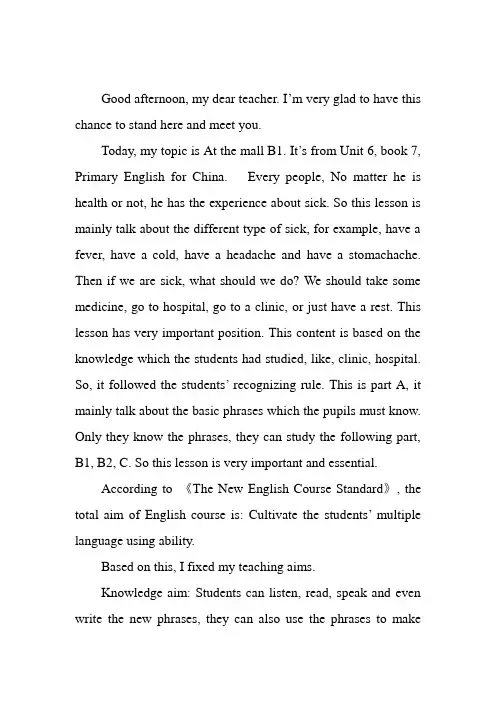
Good afternoon, my dear teacher. I’m very glad to have this chance to stand here and meet you.Today, my topic is At the mall B1. It’s from Unit 6, book 7, Primary English for China. Every people, No matter he is health or not, he has the experience about sick. So this lesson is mainly talk about the different type of sick, for example, have a fever, have a cold, have a headache and have a stomachache. Then if we are sick, what should we do? We should take some medicine, go to hospital, go to a clinic, or just have a rest. This lesson has very important position. This content is based on the knowledge which the students had studied, like, clinic, hospital. So, it followed the students’ recognizing rule. This is part A, it mainly talk about the basic phrases which the pupils must know. Only they know the phrases, they can study the following part, B1, B2, C. So this lesson is very important and essential.According to 《The New English Course Standard》, the total aim of English course is: Cultivate the students’multiple language using ability.Based on this, I fixed my teaching aims.Knowledge aim: Students can listen, read, speak and even write the new phrases, they can also use the phrases to makesimple sentences, such as “I have a headache….”. And then they can give some suggestions, such as “You should have a rest. You should…”.Ability aim: Students can make their own dialogue and can communicate with others by using the phrases what they had learned when this situation happened in their daily life.Emotional aim: Students recognize the importance of health. They know how to care about other people, especially their parents, their friends, their teachers or their classmate.So here, I should point out, the main and difficult points are that the students can master the new phrases and can use them flexibly.According to the content and important points, I use many different methods. Such as: speaking and reading method, situation teaching method, practicing method, interesting method. Sometimes students should study alone, and sometimes they should cooperate with their partner.All in all, I want the students to study in a very happy, relaxed and harmonious atmosphere.I will use computer, cards and even my body to help me. Then, I’m going to say my teaching process.Step 1: Warming upSing a song and have a free talk. Mainly talk about the weather, the date to review the sentences they had studied, and by this way, I guide the students into the English world. This is important.Step 2: Leading inToday is August 7, 2008. The Olympic game will held in Beijing tomorrow. All of us are lucky; we have the tickets of the bird nest. But koko cannot come to Beijing, Can you guess, why?I use the situation teaching method to start my class.Step 3: PresentationTeach them the new phrases, using my body to help me. Play some simple games, such as: guessing game, shake the card, do as I say, say as I do, chant and so on.Step 4: Consolidate(1). Play the tape to practice their listening.(2). Let them to read and imitate after me. This is in order to practice their reading.I should pay more attention to their pronunciation and intonation.(3). Work in group of four to make dialogue to practice their speaking.(4). Let them to do some exercise to practice theirwriting.Step 5: Expend knowledgeTell them more knowledge, such as new word, toothache, mouth ache, hand ache, ……And some new sentence structures, like, What’s wrong with you? You need to…Step 6: HomeworkAccording to the new English course standard, we should pay more attention to the students’ real desire. So, I will let the students design their homework by themselves.。
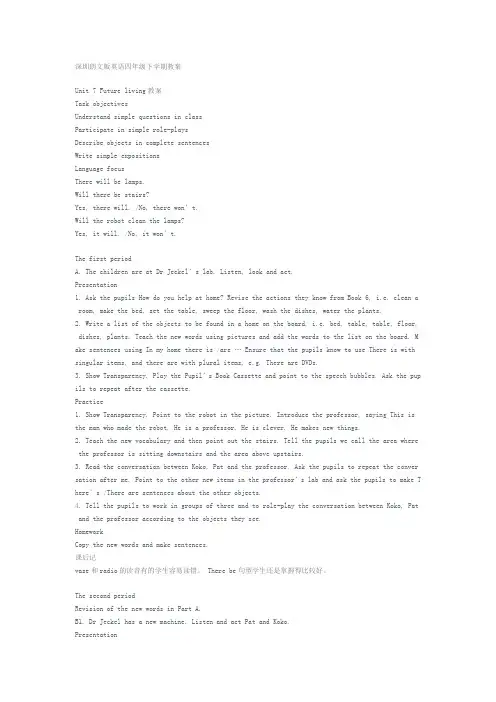
深圳朗文版英语四年级下学期教案Unit 7 Future living教案Task objectivesUnderstand simple questions in classParticipate in simple role-playsDescribe objects in complete sentencesWrite simple expositionsLanguage focusThere will be lamps.Will there be stairs?Yes, there will. /No, there won’t.Will the robot clean the lamps?Yes, it will. /No, it won’t.The first periodA. The children are at Dr Jeckel’s lab. Listen, look and act.Presentation1. Ask the pupils How do you help at home? Revise the actions they know from Book 6, i.e. clean a room, make the bed, set the table, sweep the floor, wash the dishes, water the plants.2. Write a list of the objects to be found in a home on the board, i.e. bed, table, table, floor, dishes, plants. Teach the new words using pictures and add the words to the list on the board. M ake sentences using In my home there is /are … Ensure that the pupils know to use There is with singular items, and there are with plural items, e.g. There are DVDs.3. Show Transparency. Play the Pupil’s Book Cassette and point to the speech bubbles. Ask the pup ils to repeat after the cassette.Practice1. Show Transparency. Point to the robot in the picture. Introduce the professor, saying This is the man who made the robot. He is a professor. He is clever. He makes new things.2. Teach the new vocabulary and then point out the stairs. Tell the pupils we call the area where the professor is sitting downstairs and the area above upstairs.3. Read the conversation between Koko, Pat and the professor. Ask the pupils to repeat the conver sation after me. Point to the other new items in the professor’s lab and ask the pupils to make T here’s /There are sentences about the other objects.4. Tell the pupils to work in groups of three and to role-play the conversation between Koko, Pat and the professor according to the objects they see.HomeworkCopy the new words and make sentences.课后记vase和radio的读音有的学生容易读错。
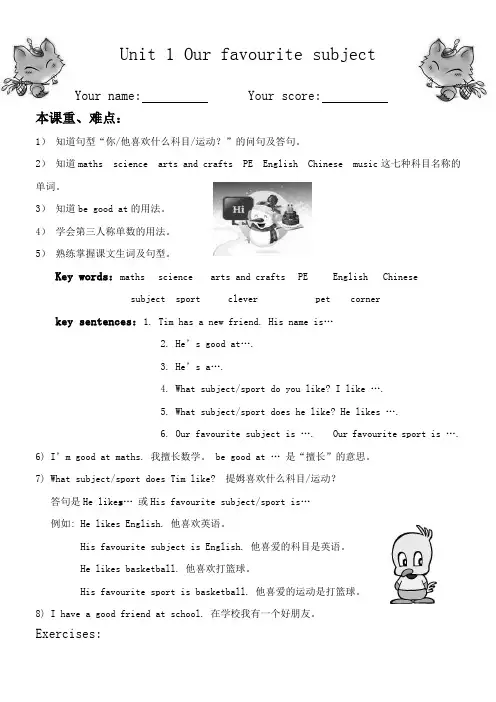
Unit 1 Our favourite subjectYour name: Your score:本课重、难点:1)知道句型“你/他喜欢什么科目/运动?”的问句及答句。
2)知道maths science arts and crafts PE English Chinese music这七种科目名称的单词。
3)知道be good at的用法。
4)学会第三人称单数的用法。
5)熟练掌握课文生词及句型。
Key words:maths science arts and crafts PE English Chinesesubject sport clever pet cornerkey sentences:1. Tim has a new friend. His name is…2. He’s good at….3. He’s a….4. What subject/sport do you like? I like ….5. What subject/sport does he like? He likes ….6. Our favourite subject is …. Our favourite sport is ….6) I’m good at maths. 我擅长数学。
be good at …是“擅长”的意思。
7) What subject/sport does Tim like? 提姆喜欢什么科目/运动?答句是He like s…或His favourite subject/sport is…例如: He likes English. 他喜欢英语。
His favourite subject is English. 他喜爱的科目是英语。
He likes basketball. 他喜欢打篮球。
His favourite sport is basketball. 他喜爱的运动是打篮球。
8) I have a good friend at school. 在学校我有一个好朋友。
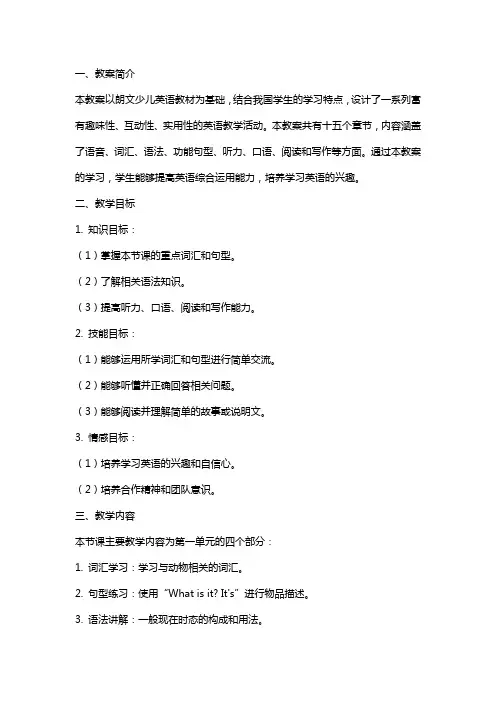
一、教案简介本教案以朗文少儿英语教材为基础,结合我国学生的学习特点,设计了一系列富有趣味性、互动性、实用性的英语教学活动。
本教案共有十五个章节,内容涵盖了语音、词汇、语法、功能句型、听力、口语、阅读和写作等方面。
通过本教案的学习,学生能够提高英语综合运用能力,培养学习英语的兴趣。
二、教学目标1. 知识目标:(1)掌握本节课的重点词汇和句型。
(2)了解相关语法知识。
(3)提高听力、口语、阅读和写作能力。
2. 技能目标:(1)能够运用所学词汇和句型进行简单交流。
(2)能够听懂并正确回答相关问题。
(3)能够阅读并理解简单的故事或说明文。
3. 情感目标:(1)培养学习英语的兴趣和自信心。
(2)培养合作精神和团队意识。
三、教学内容本节课主要教学内容为第一单元的四个部分:1. 词汇学习:学习与动物相关的词汇。
2. 句型练习:使用“What is it? It's”进行物品描述。
3. 语法讲解:一般现在时态的构成和用法。
4. 听力练习:听懂并回答有关动物的问题。
四、教学步骤1. 热身活动(5分钟)通过歌曲、游戏等方式引导学生复习上节课的内容,营造轻松愉快的课堂氛围。
2. 词汇学习(10分钟)利用图片、实物等展示本节课的动物词汇,引导学生跟读并记忆。
3. 句型练习(10分钟)分组进行角色扮演,让学生运用“What is it? It's”句型进行物品描述。
4. 语法讲解(10分钟)通过例句和练习,讲解一般现在时态的构成和用法,让学生进行相关练习。
5. 听力练习(10分钟)播放听力材料,学生听懂后回答相关问题。
6. 课堂总结(5分钟)对本节课所学内容进行总结,强调重点词汇和句型。
五、课后作业1. 抄写本节课的重点词汇和句型。
2. 完成课后练习题。
3. 预习下节课内容。
六、教学评价1. 课堂表现评价:观察学生在课堂上的参与程度、合作意识和发音准确性。
2. 课后作业评价:检查学生抄写词汇和句型的准确性,以及课后练习的完成情况。
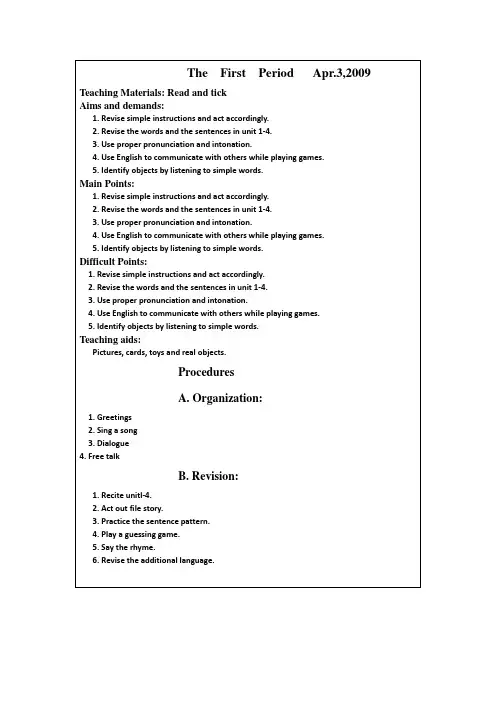
it 5 RevisionThe fourth period Apr.13th,2009A.Contents:Part D ---listen and trace the correct lines & the content of unit 4B. Teaching aims:1)Finish Exercises.2)Review the learned words and sentences of Unit 4.C. Main points:Review the learned words and sentences of Unit 4.D. Difficult points:Review the learned words and sentences of Unit 4.E.Teaching aids:Word cards softwareF. Teaching steps and methods:anization:Free talk.2.Revision:1)Read Unit 4.2)Review the learned words and sentences of Unit 4.3.Presentation:Part D ---listen and trace the correct linesPlay the tape. Use transparency to show the pupils how to traceover the dotted lines to indicate the route which the people taketo see the animals.2. Check the pupils’ answers with the help of transparency.4.Practice:Exercise: Workbook (P25~~26)1) Ask the pupils to listen to the workbook cassette and circle thewords that contain the sound they hear.2) Check the answers.Workbook(P27~28)1)Ask the pupils to read the speech bubbles. They should put atick in the box if the words and pictures match and put across in the box if they do not match.2)Check the answers.5.Summing up:We’ve reviewed Unit 4 today.6.Homework:1) Listen to the tape of unit 4 for three times.2) Prepare test.G. Write on the blackboard:Unit 5 Revisiona panda a lion a giraffe a liona monkey an elephantNotes:The important point of this period is t o review the words and sentences ofUnit1-4.Most of them can review the words and sentences patterns. But some of them confused with the words which we learnd in Unit2. They should review them more.。
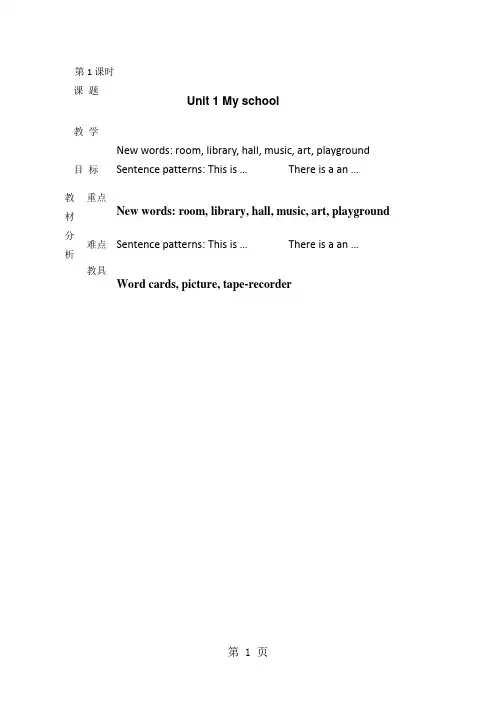
第1课时课题Unit 1 My school 教学目标New words: room, library, hall, music, art, playground Sentence patterns: This is …There is a an …教材分析重点New words: room, library, hall, music, art, playground 难点Sentence patterns: This is …There is a an …教具Word cards, picture, tape-recorder教学过程I. Free talkⅡ. Presentation1.Bring in a picture of a school and photos or pictures of thedifferent rooms taught in the Unit.2.( Books closed ) Show the picture of you the school, sayingThis is my school. Give individual pupils the picture and ask them to repeat the sentence.3.Show the pictures of the different rooms in the school. Saytheir names and ask the pupils to repeat them after me Then practise by showing a room and asking the pupils to tell me the name.4.Choose a picture and point to something in the picture thepupils know, e. g. a tree, a well-known room and say There’s a/an …Show the picture to individual pupils and ask them to point to the object and repeat the sentence. Point to other known items in the picture and encourage them to make sentences about them.5.Play the Pupil’s Book Cassette and point to the speechbubble. Ask the pupils to repeat after the beeps.Ⅲ. Practice1.( Books open ) Show Transparency. Point to the places in theschool on the page, saying There’s a classroom, etc.Encourage the pupils to repeat the sentences after you.2.Introduce the new character, Mike. Explain that Tim isshowing Mike a picture of his school. Teach the pupils the name of the school ( No. 1 Primary School ).教学过程3.Read Tim’s speech bubble. Get the pupils to point to thecorrect places. Make sentences about the other places using There’s a/an …4.Encourage the pupils to make sentences by using there is a/an…while I point to the places in the picture.5.Get the pupils to look at each of the rooms. Point at anobject in a room and say There’s a …布置作业1.Copybook 12.Workbook 13. Write the newwords on thenotebook.板书设计Unit 1 My schoolwords(picture cards)This is my school.There’s an art room.There’s a library.教学后记1.Teaching new words with motions impresses pupils.ing ‘a’ and ‘an’ should be emphasized.3. Pupils feel hard in pronouncing the words library, hall, and playground.第2课时课题Unit 1 My school教学目标New words: art room, music room, hall, library …Sentence patterns: Welcome to …Is there a …Yes, there is./ No, there isn’t.New words: art room, music room, hall, library…Sentences: Is there a … Yes, there is. / No, there isn’t.Word cards, picture, tape-recorderⅠ. Free talkⅡ. PresentationMake a plan of your school with the places marked on it.The plan does not need to have the English names written on it.( Books closed ) Show the pupils a plan of your school with the places marked on it, revising the English names for the places.Point to the plan and ask, for example, Is there a music room? Ask a pupil to come out and point to the place named and say Yes, there is. Ask about a place not in the school, e.g. Is there a swimming pool? Is there a zoo? Then teach No, there isn’t.4. ( Books open ) Show Transparency. Play the Pupil’sBook Cassette and ask the pupils to repeat the characters’ words after the beeps.Ⅲ. Practice1.Show Transparency and play the Pupil’s Book Cassette.Explain that Tim and Pat are visiting Mike’s school. The Ss listen and follow in their books. Continue to play the cassette and ask the pupils to repeat.2.Show the words in Tim and Pat’s thought bubbles. Drillthe question form with the pupils by giving them the six word cues one by one and getting the pupils to ask Is there a/an …? For each place in the school.3.Show the words with ticks and crosses in Mike’sthought bubble. Explain that a tick means they should answer Yes, there is. A cross means that they should answer No, there isn’t.4.Divide the class into three groups to role-play Tim, Patand Mike. Get them to chorus the conversation following the order of the word cues in Tim and Pat’s thought bubbles.1.Copybook 22.Workbook 23.Review whatwe learnedtoday.Unit1 My schoolWelcome to my school!Is there a …Is there an …Yes, there is./No, there isn’t.1. Practice the sentence with the plans of different school,doing a survey, or drawing a plan of pupils’ ideal school may enable the lesson more interesting.2. Pupils need to be remind to add a ‘a’ in the sentence.第3课时Unit 1 My school教学目标New words: can’t coolSentence patterns: Come and have a look.Is there a/an …?Yes, there is./ No, there isn’t. Words and sentence patternsSentence patterns: Is there a/an… Yes, .../ No, … Picture cards, tape-recorderⅠ. Free talkWhat’s in your classroom?Is there a computer?Yes, there is. / No, t here isn’tWhat’s on your desk?Is there a pencil case?…Ⅱ. Presentation1.Point to the characters in the pictures and read their speechbubbles aloud. Ask the pupils to point to the speech bubbles as you read them.2.Play the Pupil’s Book Cassette for the pu pils and ask them to saythe sentences after the cassette.3.Explain that the man in the story is the school principal.4.Ask questions about what the boy can do, e. g. Can he sing ?Encourage the pupils to answer Yes, he can./ No, he can’t.5.Ask the pupils to role-play the story in groups of three and toread the characters’ speech bubbles. Some groups may like to come out to the front and act the story.6.You may use Storycards to revise sequence and language of thestory.Ⅲ. Tick ( ) or cross ( )1.Ask the pupils to read the story again. I Read the words in thespeech bubbles with the pupils.2.Demonstrate how to tick or cross the first sentence with thepupils as an example. If the pupils are not sure of the answergo back and read the story with them again until they find theanswer.3.Check answers using Transparency.Ⅳ. SummaryI can sing. I can draw.I can’t sing. I can’t draw.1.Copybook P32.Workbook P33. Review what we learned todayUnit 1 My schoolIs there an art room? Yes, there is. /No, there isn’t.I can’t swim.I can play.1.Pupils have difficulty in understanding ‘come and have a look’, so they needto be told the meaning and some situations and some practice are needed.2.Pupils have fun in reading the story imitating the record.With the guidance of the teacher, better pupils can retell the story---- feel delighted第4课时Unit 1 My school教学目标The pronunciation of “ou” in the following words: out, around, shout, playgroundsound “ou” in the words: around, shout, playgroundsound “ou” in the words: around, shout, playgroundPicture cards, tape-recorderⅠ.Free talkWhat’s in your pencil case?Is there a rubber?Is there a ruler?Yes, there is. /No, there isn’t.Are there any pencils?Yes, th ere are. /No, there aren’t.Ⅱ. Presentation ( E. say the sound and the words.)1.Play the Pupil’s Book cassette and ask the pupils to listen to thesound and the words. Point out the spelling of this sound. It is important that the pupils realize the vowel sound is spelt with two letters. Demonstrate how to make the sound and get the pupils to look a t your face while doing so. Check that the pupils are opening their mouths sufficiently and making the sound correctly.2.Say the words slowly and clearly. Check that the pupils aresaying the sound correctly.3.Point to the pictures and check that the pupils can say thewords without your model.4.Play the Pupil’s Book Cassette again. Ask the pupils to listen tothe rhyme and to tick the correct picture. Get the pupils to say the rhyme.Ⅲ. More to do. ( Workbook P.4 )1.Ask Ss to look at the first part of the page and listen to theWorkbook Cassette.2.Draw a line to the correct words according to what they hearon the tape.Tapescript and answers: ou ( mouth, playground )3. Ask Ss to look at the second part of the page. Tell them to lookat the pictures and fill in the blanks in the sentence.What’s in your school? Is there a library? Yes, there is. What’s in your school? Is there an art room? No, there isn’t.1.Copybook P42.Workbook P43. Review what we learned todayUnit 1 My school out, around, shout, playgroundgo out run aroundin the playgroundPupils feel hard to pronounce the word round and shout for they have never learned these words. So more practise is needed. Saying the rhyme with clapping hands for several times make pupils feel more interesting.第5课时Unit 1 My school教学目标Get Ss to be more familiar with the words and the sentence patterns “There be”“ Is there a/an …”“Yes, there is/No, …”Words and sentence patterns Is there a/an … Yes, ../No,.. Words and sentence patterns Is there a/an … Yes, ../No,..Word cards, pictures and tape-recorderⅠ. Free talkWhat’s in your room?Is there a big TV?Is there a computer?Is there a fan?Yes, there is. /No, there is n’t.Ⅱ. Revision1.Review the wordclassroom, library, hall, music room, art room, playground…2. Choose some students to spell the words, and choose someable students, make sentences with these words.Ⅲ. Presentation ( F. Look and do. P.5)1.Tell the pupils to work in pairs. One should be Student A andthe other one Student B. ask all the pupils who are studentA to put up their hands. Repeat with the pupils who areStudent B.2.Read the instructions on the page with the pupil. Ask themto turn to pages 60 and 61. point out the different plans Students A and B should look at. Explain that the places on the plans are the same, but the objects are in different places.3.Tell the pupils to put ticks in the correct places in the grid onpage 60 or page 61.4.Demonstrate one conversation by having one student A ask,e.g. Is there a fan? Get Student B to answer No, there isn’t.Then have Student A ask Is there a TV?Get Student B to answer Yes, there is. It’s in the classroom. Show the pupils that Student A should tick the box across from classroom and under the TV in the grid.IV. Tell them to take turns to ask and answer questions and to put ticks in their grid according to their partner’s answers.V. Summary1. Workbook P52. Review what we learned today Unit 1 My school Is there a fan? No, there isn’t.Is there a TV? Yes, there is.It’s in the classroom.第6课时Unit 1 My school教学目标Consolidate all the new words and sentence patterns of Unit 1Part G: Sing the songsThe words and sentence patterns in unit1 Sentence patterns in unit1Word cards, picture cards, tape-recorder, projectorI. Free talkWhat’s the weather li ke today?Is there a computer in the classroom?Are there any fans in the classroom?How many fans in the classroom?Ⅱ. Revision1.Review the new wordsart room, library, hall, music room, playground, classroom, computer room, music room, around, shout2. Review sentence patterns.This is my school. There’s an art room. There’s a library.Welcome to my school!Is there a library?Yes, there is./ No, there isn’t.Ⅲ. Sing and play1.Play the Pupil’s Book Cassette for the pupils to listento the song.2.Play the cassette again and tell the pupils to tick thecorrect pictures for the rooms in the first two versesof the song.3.Play the cassette again and encourage the pupils tojoin in with the words. Then point to one of therooms shown at the bottom of the page and ask thepupils to sing the next three verses substituting thename of the room I point to.Ⅳ. Workbook. (P5)1. Ask the pupils to read the speech bubbles in thepictures on the left.2. Then match them to the pictures on the right bywriting the correct letter in the circle.Ⅴ. Summary1.Read partA and partB together.2.Sing the songs again.1.Review the words and Part A,B,C,D,E,F.2.Prepare Unit 2Unit 1 My school There is an art roomIn my school,In my school, There’s an art room in …My sc hool’s cool.。

![小学英语优秀说课稿[1]](https://uimg.taocdn.com/fb2543283169a4517723a37b.webp)
小学英语优秀说课稿模板一、说教材香港朗文教材在内容的设计上和深港版教材相比,难度要高。
从第四单元开始,就进入现在进行时的学习,和前面三个单元的内容联系不大,唯一的联系就是出现之前学习过的几个关于动物的名词。
本单元的主要内容有两个:一)学习六个新的动词及其现在分词形式。
其中,有三个动词属于重读闭音节,其分词形式变化涉及特殊规则,要双写词尾字母。
因为本单元是第一次出现现在进行时的学习内容,因此,我们采取淡化处理,不特别强调分词的变化规则,只要求学生对此有过初步的印象。
二)在此基础之上,用有关动物的名词做主语,并对单数主语和复数主语进行区分,学习用现在进行时来描述动物的动作。
本单元只出现陈述句,在下一单元也就是第五单元才开始对疑问句的学习。
可以根据学生对现在进行时的掌握情况适当进行一些疑问句的拓展,为下一单元的学习起个铺垫作用,但要掌握好度。
二、说教法根据学生的认知规律,尤其是低年级教学,应当注意培养学生对这门学科的兴趣,保持强烈的好奇心和旺盛的求知欲。
遵循这一原则,我采用如下教法:1.任务型教学法:让学生通过思考、调查、讨论、交流和合作等方式学习和使用英语完成学习任务。
2.情景教学法:多媒体辅助教学集图像、声音、文字于一体,利用多媒体或实物为学生创设情景,使教学内容更生动、形象,吸引学生的注意力,让学生身临其境地学习英语。
3.游戏教学法:通过唱歌、游戏及体态语言启发诱导学生完成本课任务。
4、交际法:学习英语,目的在于用英语进行交际。
遵循这一原则,尽量创造机会让学生与学生,学生与老师之间进行对话,培养学生的语言交际能力。
三、说学法教学目标是教学活动的出发点和归宿,根据新课标以及大纲要求,结合以上分析,我确定本课的教学目标如下:(一)、教学目标1、知识目标(LINGUISTIC FACTORS):(1)能正确听、说、读、词汇eat/eating, sleep/sleeping, fight/fighting, hop/hopping, swim/swimming, run/running 在此基础之上,能拼写以上单词的部分字母;(2)正确听、说、读、句型The elephant is sleeping. /The hippo is eating.The rabbits are hopping. /The turtles are swimming.在此基础之上,能利用已经学过的词汇进行语言的创造。
深圳小学英语说课稿范文全英文版English: In this English lesson plan for a primary school in Shenzhen, we will focus on developing students' speaking skills through interactive activities. The lesson aims to engage students in meaningful conversations while introducing new vocabulary related to daily routines. The lesson will begin with a warm-up activity where students greet each other using the target vocabulary. Following this, the teacher will present the new vocabulary through visuals and real-life scenarios, encouraging students to repeat and practice pronunciation. To reinforce understanding, students will participate in pair and group activities such as role-plays and discussions about their own daily routines. Throughout the lesson, the teacher will provide feedback and correction to improve students' pronunciation and fluency. Finally, the lesson will conclude with a review activity to consolidate learning and assess students' progress.Translated content: 在这个针对深圳小学的英语说课稿中,我们将通过互动活动来重点培养学生的口语能力。
深圳小学英语二年级说课稿范文Teaching a second-grade English class in Shenzhen primary school can be a rewarding and challenging experience. As an educator, it is important to create engaging lesson plans that cater to the unique needs and abilities of young learners. In this sample lesson plan, I will outline the key components of a comprehensive English lesson for a second-grade class in Shenzhen.The primary objective of this lesson is to introduce and reinforce the use of basic vocabulary related to common household items. By the end of the lesson, students should be able to identify, name, and describe various household objects in English. This lesson will also incorporate elements of listening, speaking, and reading comprehension to provide a well-rounded learning experience.The lesson begins with a warm-up activity designed to capture the students' attention and activate their prior knowledge. The teacher will start by holding up a common household item, such as a pencil or a book, and asking the class "What is this?" in English. The students will be encouraged to respond with the English word for theobject. This interactive exercise will help students become familiar with the target vocabulary and prepare them for the main lesson activities.Next, the teacher will introduce the new vocabulary words through a series of engaging visual aids. The teacher will display images of various household items and provide the English name for each object. Students will be asked to repeat the vocabulary words after the teacher, focusing on correct pronunciation and intonation. To further reinforce the new vocabulary, the teacher may use flashcards, interactive whiteboard presentations, or physical objects to help students associate the English words with their corresponding visual representations.After the vocabulary introduction, the class will participate in a listening comprehension activity. The teacher will read a short story or description that features the target household vocabulary words. As the story is read aloud, students will be asked to raise their hands or point to the appropriate household item when they hear it mentioned. This activity will not only help students practice their listening skills but also solidify their understanding of the new vocabulary.To provide opportunities for speaking practice, the teacher will then organize the class into small groups or pairs. Each group will begiven a set of household item images and asked to take turns describing the objects to their peers. Students will be encouraged to use complete sentences, such as "This is a pen" or "The book is red," to demonstrate their ability to use the vocabulary in context.The lesson will also incorporate a reading comprehension component. The teacher will distribute a short text or worksheet that features the target household vocabulary words. Students will be asked to read the text and answer comprehension questions or complete fill-in-the-blank exercises to assess their understanding of the vocabulary in a written context.To conclude the lesson, the teacher will conduct a review activity to reinforce the key vocabulary concepts. This may involve a game, such as "Simon Says" or "Household Item Bingo," where students must listen for and identify the correct household items. The teacher may also distribute a worksheet or activity page for students to complete independently, further solidifying their mastery of the vocabulary.Throughout the lesson, the teacher will employ a variety of teaching strategies and techniques to cater to the diverse learning styles and needs of the second-grade students. Incorporation of visual aids, hands-on activities, and interactive exercises will help maintain the students' engagement and foster a positive learning environment.Additionally, the teacher will provide ample opportunities for students to practice and apply the new vocabulary in meaningful contexts. By engaging the students in listening, speaking, and reading activities, the lesson will ensure that the students develop a well-rounded understanding of the target vocabulary and are able to use it effectively in their daily lives.In conclusion, this sample lesson plan for a second-grade English class in Shenzhen primary school highlights the importance of creating a comprehensive and engaging learning experience for young learners. By incorporating a range of instructional strategies and focusing on the development of vocabulary, listening, speaking, and reading skills, the teacher can effectively facilitate the students' language acquisition and foster a love for learning English.。
深圳小学英语二年级说课稿范文English:For a second-grade English class in Shenzhen, it's crucial to create an engaging and interactive lesson plan that caters to the students' learning needs and interests. The lesson should incorporate a variety of activities such as songs, games, and hands-on exercises to enhance language acquisition and retention. It's essential to introduce vocabulary and grammar structures in a fun and memorable way, using visual aids and gestures to aid comprehension. Additionally, integrating elements of Chinese culture into the lesson can foster cultural appreciation and make learning English more relatable for the students. Throughout the lesson, it's important to provide ample opportunities for students to practice speaking, listening, reading, and writing in English, fostering a communicative and immersive learning environment. By the end of the lesson, students should feel confident and motivated to continue their English language journey.中文翻译:对于深圳的二年级英语课程来说,制定一个引人入胜、互动性强的课堂计划至关重要,以满足学生的学习需求和兴趣。
深圳版小学英语说课稿模板尊敬的各位老师,大家好。
今天我将为大家展示一堂深圳版小学英语课程的说课稿模板。
这堂课的主题是《Friendship》,旨在通过一系列的教学活动,让学生理解友谊的重要性,并学会如何用英语表达对朋友的感激之情。
课程导入:课程开始时,我会用一段简短的英文歌曲《You've Got a Friend》来吸引学生的注意力,并引导他们思考友谊的意义。
歌曲结束后,我会提问学生:“Can you tell me what friendship means to you?”通过这个问题,激发学生对友谊的思考。
新课呈现:接下来,我会展示一些关于友谊的图片和短文,让学生通过视觉和阅读来感受友谊的美好。
在展示过程中,我会重点教授一些与友谊相关的词汇,如:friend, support, care, trust等。
词汇学习:在词汇学习环节,我会使用图片和实物来帮助学生记忆单词。
例如,展示一张朋友帮助的照片,然后指着图片说:“This is support.”通过这种方式,学生可以更直观地理解单词的含义。
语法点讲解:本节课的语法重点是学习如何使用一般现在时来描述朋友之间的行为。
我会通过举例和练习来帮助学生掌握这一语法点。
例如:“Tomalways helps me with my homework.”互动练习:在互动练习环节,我会组织学生进行角色扮演。
学生将被分成小组,每组选择一个与友谊相关的场景进行表演,如:朋友之间的帮助、分享快乐等。
通过这种方式,学生可以在实际语境中运用所学的语言点。
总结与作业:课程的最后,我会总结今天学习的重点,并布置相关的作业。
作业可以是写一篇关于友谊的小短文,或者画一幅表达友谊的画,并附上简短的英文说明。
结束语:通过今天的学习,我希望学生们能够更加珍视身边的友谊,并学会用英语表达对朋友的感激。
谢谢大家的聆听,期待在课堂上与大家的进一步交流。
这就是我为大家准备的深圳版小学英语说课稿模板,希望能够对大家的教学有所启发和帮助。
Good afternoon, my dear teacher. I’m very glad to have this chance to stand here and meet you.Today, my topic is At the mall B1. It’s from Unit 6, book 7, Primary English for China. Every people, No matter he is health or not, he has the experience about sick. So this lesson is mainly talk about the different type of sick, for example, have a fever, have a cold, have a headache and have a stomachache. Then if we are sick, what should we do? We should take some medicine, go to hospital, go to a clinic, or just have a rest. This lesson has very important position. This content is based on the knowledge which the students had studied, like, clinic, hospital. So, it followed the students’ recognizing rule. This is part A, it mainly talk about the basic phrases which the pupils must know. Only they know the phrases, they can study the following part, B1, B2, C. So this lesson is very important and essential.According to 《The New English Course Standard》, the total aim of English course is: Cultivate the students’multiple language using ability.Based on this, I fixed my teaching aims.Knowledge aim: Students can listen, read, speak and even write the new phrases, they can also use the phrases to make simple sentences, such as “I have a headache….”. And then they can give somesuggestions, such as “You should have a rest. You should…”.Ability aim: Students can make their own dialogue and can communicate with others by using the phrases what they had learned when this situation happened in their daily life.Emotional aim: Students recognize the importance of health. They know how to care about other people, especially their parents, their friends, their teachers or their classmate.So here, I should point out, the main and difficult points are that the students can master the new phrases and can use them flexibly.According to the content and important points, I use many different methods. Such as: speaking and reading method, situation teaching method, practicing method, interesting method. Sometimes students should study alone, and sometimes they should cooperate with their partner.All in all, I want the students to study in a very happy, relaxed and harmonious atmosphere.I will use computer, cards and even my body to help me. Then, I’m going to say my teaching process.Step 1: Warming upSing a song and have a free talk. Mainly talk about the weather, the date to review the sentences they had studied, and by this way, I guide the students into the English world. This is important.Step 2: Leading inToday is August 7, 2008. The Olympic game will held in Beijing tomorrow. All of us are lucky; we have the tickets of the bird nest. But koko cannot come to Beijing, Can you guess, why?I use the situation teaching method to start my class.Step 3: PresentationTeach them the new phrases, using my body to help me. Play some simple games, such as: guessing game, shake the card, do as I say, say as I do, chant and so on.Step 4: Consolidate(1). Play the tape to practice their listening.(2). Let them to read and imitate after me. This is in order to practice their reading.I should pay more attention to their pronunciation and intonation.(3). Work in group of four to make dialogue to practice their speaking.(4). Let them to do some exercise to practice their writing.Step 5: Expend knowledgeTell them more knowledge, such as new word, toothache, mouth ache, hand ache, …… And some new sentence structures, like, What’s wrong with you? You need to…Step 6: HomeworkAccording to the new English course standard, we should pay more attention to the students’ real desire. So, I will let the students design their homework by themselves.。
小学英语说课稿(深圳朗文版)
Good afternoon, my dear teacher. I’m very glad to have this chance to stand here and meet you.
Today, my topic is At the mall B1. It’s from Unit 6, book 7, Primary English for China. Every people, No matter he is health or not, he has the experience about sick. So this lesson is mainly talk about the different type of sick, for example, have a fever, have a cold, have a headache and have a stomachache. Then if we are sick, what should we do? We should take some medicine, go to hospital, go to a clinic, or just have a rest. This lesson has very important position. This content is based on the knowledge which the students had studied, like, clinic, hospital. So, it foll owed the students’ recognizing rule. This is part A, it mainly talk about the basic phrases which the pupils must know. Only they know the phrases, they can study the following part, B1, B2, C. So this lesson is very important and essential.
According to 《The New English Course Standard》, the total aim of English course is: Cultivate the students’multiple language using ability.
Based on this, I fixed my teaching aims.
Knowledge aim: Students can listen, read, speak and even write the new phrases, they can also use the phrases to make simple sentences, such as “I have a headache….”. And then they can give some suggestions, such as “You should have a rest. You should…”.
Ability aim: Students can make their own dialogue and can communicate with others by using the phrases what they had learned when this situation happened in their daily life.
Emotional aim: Students recognize the importance of health.
They know how to care about other people, especially their parents, their friends, their teachers or their classmate.
So here, I should point out, the main and difficult points are that the students can master the new phrases and can use them flexibly.
According to the content and important points, I use many different methods. Such as: speaking and reading method, situation teaching method, practicing method, interesting method. Sometimes students should study alone, and sometimes they should cooperate with their partner.
All in all, I want the students to study in a very happy, relaxed and harmonious atmosphere.
I will use computer, cards and even my body to help me. Then, I’m going to say my teaching process.
Step 1: Warming up
Sing a song and have a free talk. Mainly talk about the weather, the date to review the sentences they had studied, and by this way, I guide the students into the English world. This is important.
Step 2: Leading in
Today is August 7, 2008. The Olympic game will held in Beijing tomorrow. All of us are lucky; we have the tickets of the bird nest. But koko cannot come to Beijing, Can you guess, why?
I use the situation teaching method to start my class.
Step 3: Presentation
Teach them the new phrases, using my body to help me. Play some simple games, such as: guessing game, shake the card, do as I say, say as I do, chant and so on.
Step 4: Consolidate
(1). Play the tape to practice their listening.
(2). Let them to read and imitate after me. This is in order to practice their reading.I should pay more attention to their pronunciation and intonation.
(3). Work in group of four to make dialogue to practice their speaking.
(4). Let them to do some exercise to practice their
writing.
Step 5: Expend knowledge
Tell them more knowledge, such as new word, toothache, mouth ache, hand ache, ……And some new sentence structures, like, What’s wrong with you? You need to…
Step 6: Homework
According to the new English course standard, we should pay more attention to the students’ real desire. So, I will let the students design their homework by themselves.。